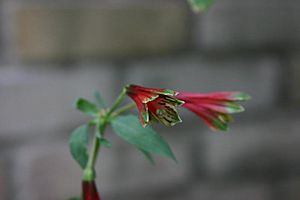Alstroemeria psittacina facts for kids
Quick facts for kids Alstroemeria psittacina |
|
|---|---|
 |
|
| Scientific classification | |
| Synonyms | |
|
Alstroemeria psittacina, also known as the Peruvian lily or parrot flower, is a beautiful plant. People also call it the parrot lily, lily of the Incas, princess lily, or New Zealand Christmas bell. This plant grows naturally in parts of Brazil and Argentina.
Contents
What is the Parrot Flower?
Alstroemeria psittacina is a type of plant that lives for many years. It has special underground parts called tubers. These tubers help the plant store food and water. This allows it to come back year after year.
How Does the Parrot Flower Look?
The flowers of this plant grow in small groups. These groups are called umbels. Each group usually has 3 to 8 flowers. The flowers can be red or reddish-purple. Sometimes, they have small brownish spots.
Where Does the Parrot Flower Grow?
This plant first came from Brazil, Argentina, and Paraguay. This means it is "native" to these countries. But people liked it so much that they started growing it in other places. Now, you can find it growing wild in many parts of the world.
Where Has It Spread?
It has spread to places like Australia (in New South Wales and Norfolk Island). You can also find it in New Zealand, the Madeira, and the Canary Islands. In the United States, it grows in the southeastern states. These include eastern Texas, Louisiana, Mississippi, Alabama, Georgia, and Florida.
Growing the Parrot Flower
People often grow Alstroemeria psittacina because its flowers are very pretty. It is known as an ornamental plant. Plant nurseries, which are places that grow and sell plants, often offer it. It is a good choice for gardens in places with mild weather, like California.
Why is it Popular in New Zealand?
This plant is very popular in New Zealand. It usually blooms, or flowers, around Christmas time there. Because of this, it earned the nickname New Zealand Christmas bell.
Is it an Invasive Plant?
Sometimes, this plant can spread very easily. When a plant spreads too much and takes over areas where other plants grow, it is called an invasive plant. Also, Alstroemeria psittacina can sometimes get a common plant virus. This virus is called the Alstroemeria mosaic potyvirus.
See also
 In Spanish: Alstroemeria psittacina para niños
In Spanish: Alstroemeria psittacina para niños
- List of plants known as lily
fr:Alstroemeria pulchella pt:Alstroemeria pulchella ro:Alstroemeria pulchella sv:Alstroemeria pulchella

